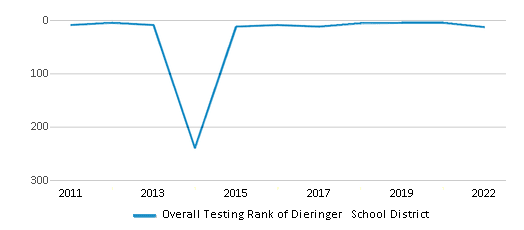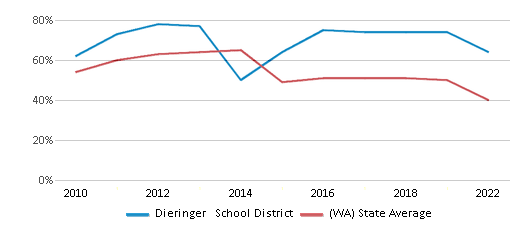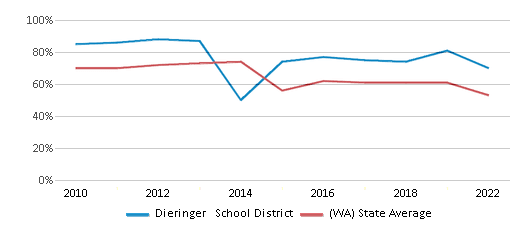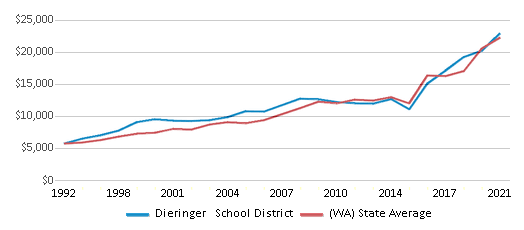Top Rankings
Dieringer School District ranks among the top 20% of public school district in Washington for:
Category
Attribute
Overall Rank
Highest overall rank (Top 5%)
Math Proficiency
Highest math proficiency (Top 5%)
Reading/Language Arts Proficiency
Highest reading/language arts proficiency (Top 10%)
Science Proficiency
Highest science proficiency (Top 20%)
For the 2025 school year, there is 1 public preschool serving 480 students in Dieringer School District. This district's average pre testing ranking is 10/10, which is in the top 10% of public pre schools in Washington.
ÎÛÎÛÂþ» Preschool in Dieringer School District have an average math proficiency score of 66% (versus the Washington public pre school average of 43%), and reading proficiency score of 71% (versus the 49% statewide average).
Minority enrollment is 38% of the student body (majority Asian and Hispanic), which is less than the Washington public preschool average of 54% (majority Hispanic).
Overview
This School District
This State (WA)
# Schools
3 Schools
801 Schools
# Students
1,439 Students
280,418 Students
# Teachers
85 Teachers
17,799 Teachers
Student : Teacher Ratio
17:1
17:1
District Rank
Dieringer School District, which is ranked within the top 10% of all 306 school districts in Washington (based off of combined math and reading proficiency testing data) for the 2021-2022 school year.
Overall District Rank
#13 out of 307 school districts
(Top 5%)
(Top 5%)

Math Test Scores (% Proficient)
64%
40%

Reading/Language Arts Test Scores (% Proficient)
70%
53%

Science Test Scores (% Proficient)
61%
49%
Students by Ethnicity:
Diversity Score
0.57
0.71
# American Indian Students
5 Students
2,844 Students
% American Indian Students
n/a
1%
# Asian Students
155 Students
25,971 Students
% Asian Students
11%
9%
# Hispanic Students
144 Students
73,094 Students
% Hispanic Students
10%
26%
# Black Students
56 Students
16,473 Students
% Black Students
4%
6%
# White Students
911 Students
129,086 Students
% White Students
63%
46%
# Hawaiian Students
18 Students
5,103 Students
% Hawaiian Students
1%
2%
# Two or more races Students
150 Students
27,229 Students
% of Two or more races Students
11%
10%
Students by Grade:
# Students in PK Grade:
44
23,952
# Students in K Grade:
120
43,573
# Students in 1st Grade:
144
42,048
# Students in 2nd Grade:
164
43,955
# Students in 3rd Grade:
142
39,809
# Students in 4th Grade:
158
41,098
# Students in 5th Grade:
158
39,252
# Students in 6th Grade:
161
3,085
# Students in 7th Grade:
169
1,010
# Students in 8th Grade:
179
1,067
# Students in 9th Grade:
-
319
# Students in 10th Grade:
-
337
# Students in 11th Grade:
-
333
# Students in 12th Grade:
-
580
# Ungraded Students:
-
-
District Revenue and Spending
The revenue/student of $21,993 is higher than the state median of $18,796. The school district revenue/student has stayed relatively flat over four school years.
The school district's spending/student of $18,186 is less than the state median of $19,246. The school district spending/student has stayed relatively flat over four school years.
Total Revenue
$32 MM
$20,715 MM

Spending
$26 MM
$21,212 MM

Revenue / Student
$21,993
$18,796

Spending / Student
$18,186
$19,246

Best Dieringer School District ÎÛÎÛÂþ» Preschools (2025)
School
(Math and Reading Proficiency)
(Math and Reading Proficiency)
Location
Grades
Students
Rank: #11.
Dieringer Heights Elementary School
(Math: 66% | Reading: 71%)
Rank:
Rank:
9/
Top 20%10
21727 34th Street E.
Bonney Lake, WA 98391
(253) 826-4937
Bonney Lake, WA 98391
(253) 826-4937
Grades: PK-5
| 480 students
Recent Articles

Year-Round Or Traditional Schedule?
Which is more appropriate for your child? A year-round attendance schedule or traditional schedule? We look at the pros and cons.

Why You Should Encourage Your Child to Join a Sports Team
Participating in team sports has a great many benefits for children, there is no doubt. In this article you will learn what those benefits are.

White Students are Now the Minority in U.S. ÎÛÎÛÂþ» Schools
Increasing birth rates among immigrant families from Asia and Central and South America, combined with lower birth rates among white families, means that for the first time in history, public school students in the United States are majority-minority. This shift in demographics poses difficulties for schools as they work to accommodate children of varying language abilities and socio-economic backgrounds.





